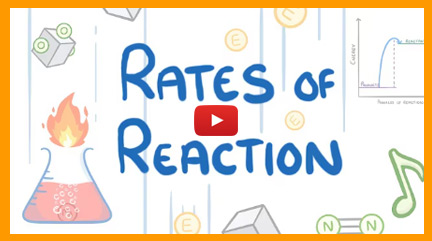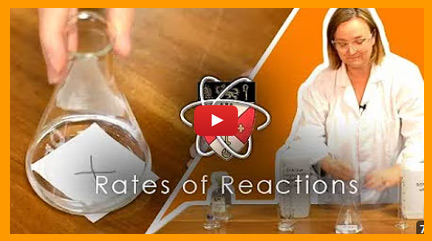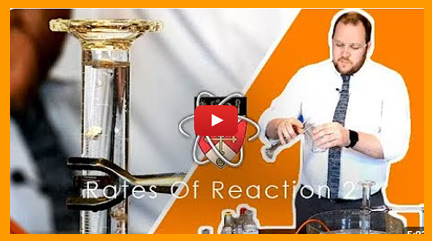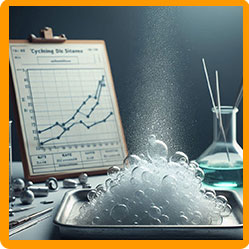
Rates of Chemical Change
The rate of a chemical reaction tells us how fast a reaction happens. Understanding what affects reaction rates helps chemists control reactions — making them faster, slower, or more efficient depending on the goal. This topic also includes reversible reactions and how conditions affect equilibrium.
Practicals on this page:
Rates of Reactions
What Is Rate of Reaction?
The rate of reaction is how quickly reactants are turned into products. It's usually measured by:
- How fast a reactant is used up
- How fast a product is formed

Measuring Rates of Reaction
There are several ways to measure the rate of a reaction:
- Gas volume – Collect gas with a gas syringe or over water.
- Mass loss – Measure decrease in mass using a balance.
- Time for visual change – e.g. the disappearing cross in the sodium thiosulfate + hydrochloric acid reaction.
These methods are commonly used in required practicals.
Factors Affecting the Rate of Reaction
Several factors affect how often particles collide and how quickly a reaction happens.
Collision Theory
Reactions happen when particles collide with enough energy. This is called a successful collision. The more frequent and energetic the collisions, the faster the reaction.
Concentration
Increasing the concentration of a solution means more particles in the same space, so collisions happen more often.
Pressure (for gases)
Higher pressure squashes gas particles into a smaller space, increasing the frequency of collisions.
Surface Area
Breaking up a solid into smaller pieces gives it a larger surface area, exposing more particles to react.
Temperature
Higher temperatures give particles more kinetic energy, so they move faster and collide more often with more energy.
Catalysts
A catalyst speeds up a reaction without being used up. It lowers the activation energy, making it easier for collisions to be successful.
Revision Notes
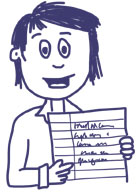
The Cornell method is like a supercharged note-taking system that helps you ace your revision!
Print out our blank revision notes pages to help you revise.
How to make effective revision notes with the Cornell method.
Exam Questions & Answers

Download and print off practice our FREE worksheet with exam style questions on Cell Biology.
Rate of Reaction Graphs
You can plot reaction data on a graph with:
- Time on the x-axis
- Amount of product or reactant on the y-axis
Steeper lines = faster reaction
Flattened line = reaction has finished
Finding Rate from a Graph
To find the rate at a specific time:
-
Draw a tangent to the curve at that point
-
Calculate the gradient (change in y ÷ change in x)
This gives you the instantaneous rate of reaction at that moment.
Reversible Reactions
In a reversible reaction, the products can react to form the original reactants again. These reactions are shown with a ⇌ symbol.
Example:

When a reversible reaction happens in a closed system, it can reach equilibrium.
Equilibrium and Le Chatelier’s Principle
Equilibrium is reached when the forward and backward reactions happen at the same rate — the amounts of reactants and products stay constant (though not necessarily equal).
According to Le Chatelier’s Principle, if conditions change, the equilibrium position will shift to oppose the change.
Changing Concentration
Increasing the concentration of a reactant shifts the equilibrium to make more products
Changing Temperature
Increasing temperature favours the endothermic direction
Decreasing temperature favours the exothermic direction
Changing Pressure (for gases)
Increasing pressure favours the side with fewer gas molecules
Decreasing pressure favours the side with more gas molecules
Endothermic and Exothermic Reactions
- Exothermic reactions give out energy to the surroundings (e.g. combustion, many neutralisations)
- Endothermic reactions take in energy (e.g. thermal decomposition, certain reversible reactions)
Understanding energy changes is key to predicting how the equilibrium will shift.
Also see Chemical Changes, Energy Changes, Electrolysis
PRACTICAL - Rates of Reactions
This practical explores how changing conditions affects the rate of a chemical reaction. You’ll usually investigate the effect of temperature, concentration, or surface area.
Two common methods are:
- Measuring gas produced – e.g. reaction of marble chips (calcium carbonate) with hydrochloric acid, collecting gas over time.
- Disappearing cross method – reaction between sodium thiosulfate and hydrochloric acid produces a cloudy sulfur precipitate that hides a cross on paper.
By timing how long it takes for a set change to occur, you can compare how different variables affect the reaction speed.
Revision Notes

The Cornell method is like a supercharged note-taking system that helps you ace your revision!
Print out our blank revision notes pages to help you revise.
How to make effective revision notes with the Cornell method.
Why Do I Need to Know About Rates of Chemical Change?
In Everyday Life
- Knowing why preservatives slow down food spoilage
- Understanding how quickly medicines or cleaning products take effect
- Learning why temperature, surface area, or concentration affects reactions (e.g. cooking)
- Making sense of chemical safety warnings or instructions
- Understanding how energy-efficient or eco-friendly a process is
In Science & Chemistry Careers
- Optimising industrial reactions to increase yield and efficiency
- Using catalysts to speed up reactions in everything from fuels to food production
- Applying Le Chatelier’s Principle to control chemical equilibria
- Designing safer and faster manufacturing processes
- Analysing reaction graphs to predict and monitor performance

